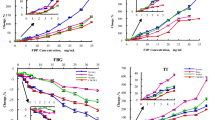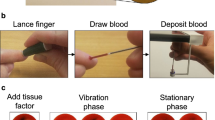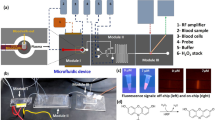Abstract
THE usual way of determining time of coagulation, which is of diagnostic importance, is to observe clot formation. There has been no report of any way of measuring coagulation time with an accuracy of a few seconds. We report here our observations of the coagulation of human plasma, using a simple, sensitive and reproducible photoelectric device developed in this laboratory to study blood coagulation. The idea originated from a suggestion of Born1.
This is a preview of subscription content, access via your institution
Access options
Subscribe to this journal
Receive 51 print issues and online access
$199.00 per year
only $3.90 per issue
Buy this article
- Purchase on Springer Link
- Instant access to full article PDF
Prices may be subject to local taxes which are calculated during checkout
Similar content being viewed by others
References
Born, G. V. R., Nature, 194, 927 (1962).
Author information
Authors and Affiliations
Rights and permissions
About this article
Cite this article
MOHAMMAD, S., REYLON, D., TEWARI, K. et al. Photoelectric Technique for estimating Plasma Coagulation Time. Nature 216, 384–385 (1967). https://doi.org/10.1038/216384b0
Received:
Revised:
Published:
Issue Date:
DOI: https://doi.org/10.1038/216384b0
Comments
By submitting a comment you agree to abide by our Terms and Community Guidelines. If you find something abusive or that does not comply with our terms or guidelines please flag it as inappropriate.



